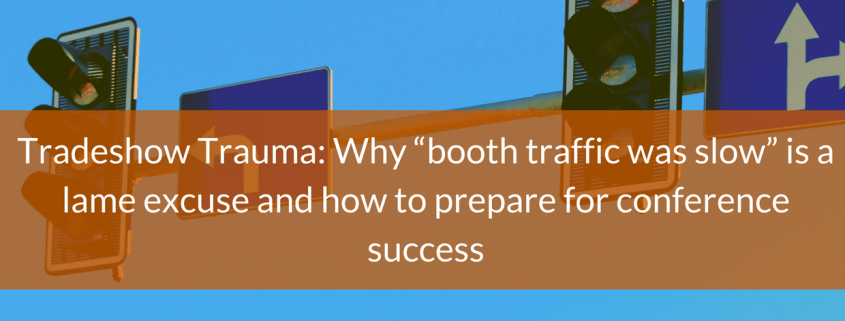
by Lisa Chernikoff | Jan 3, 2018 | Blog
As a marketing and PR professional who has spent countless hours in tradeshow booths and walked more than 20,000 steps at the HIMSS conference while wearing heels, I’ve experienced both the glory and the defeat of being an exhibitor. And while there is no better feeling than packing up your boxes, tearing down the booth and heading home after a job well done, there is also no greater pain than realizing that your company’s precious time and resources were virtually wasted because your conference strategy fell short.
After every tradeshow, it’s common to speak with exhibitors who complain that “booth traffic was slow” and cite that reason as the root of their conference failure. But let’s be honest — that’s a lame excuse. It’s the easy way out to blame poor performance at the show on exhibit hall organizers rather than reflecting on how your team may be at fault, or at least largely contributed to the problem.
In fact, upon much-needed reflection, those complainers would see that they are likely committing the cardinal sin of tradeshow marketing. They’re only focused on the conference. They’re not focused on the holistic strategy that enables the smartest, more successful companies to succeed at conferences again and again and again.
To avoid this tradeshow trauma and emerge triumphant in 2018, it’s critical for companies to have a three-pronged approach that includes not just a conference strategy where you show up and wait, but also and even more importantly a pre-conference strategy and a post-conference strategy.
Here are 4 insider secrets to help you get started:
#1 Never rely on booth traffic
Sure, booth traffic is nice and we all want it but it’s even better to drive traffic to your booth in advance. As savvy marketing professionals know, the best tradeshow marketing strategies start early and establish a regular cadence of communication. Most companies find that implementing a targeted email campaign starting 6 weeks in advance of the show is ideal but some may find that 8 weeks or 4 weeks works best for their audience.
These emails should be geared to both sales prospects to schedule meetings or demos and current clients to have a face-to-face touchpoint and determine cross-sale opportunities. As always, the top-performing emails are brief and targeted to attendees by role and job setting. It’s also best to have a form where attendees can schedule time and then receive a confirmation with a calendar invite. Why is that so important? It gets you on attendees calendars before they arrive at the show and are overwhelmed. Also, then your team can send them reminders about the scheduled slot or reach out if they don’t arrive as planned.
#2 Winning is great but winning isn’t everything
Pre-conference email campaigns can also invite attendees to activities in the booth such as speaking events or games instead of just meetings and demos. They can also offer attendees “a chance to win” and highlight big prizes, but they must not rely on the allure of a gimmick alone. There are few too many promotions for your giveaway to break through the noise. A pre-conference strategy that shares quality content, in addition to touting “a trip for 100 around the world” is the safest, most effective way to not only illustrate thought leadership but also to create brand awareness of your company as leader and innovator that offers far more than just a chance to win ““ but rather real ROI.
#3 Think like an attendee
Spoiler alert for those many hours spent in the booth. Nobody wants your marketing brochure! It will end up in the next trash can even if they take it, and if it makes it back to their room, it will end up in the hotel trash can. They also really don’t want a folder with multiple product one-pagers and a recent press release about your new product. Please note that this realization also spares your marketing team and admin hours of folder stuffing. Yes, you’re welcome.
The big idea here is to remember why attendees are at the conference. Most attendees are there to learn, not to purchase your “ground-breaking, best in class, fully integrated solution.” So, give them what they want like client case studies with real-world insights and thought leadership that demonstrates your knowledge and unique perspective. That’s the true value proposition that won’t get throw in the trash.
#4 Follow-up, follow-up, follow-up
It’s great to have a successful show, but it’s what companies do afterwards that matters most. It’s all about the follow-up communications, which should include a series of e-blasts, with the first prepared ahead of time and sent within 1-2 days of show close. The post-show e-blast should provide an opportunity to continue to engage with your company by downloading a new piece of content, registering for a webinar, or scheduling a full product demo for their broader team. However, the e-blast is not enough. To see results, it must be complimented by personalized follow-up from the sales team where there is even a small percentage chance of generating new pipeline. Without this timely and dedicated post-show communications, it’s impossible to reap the benefits of your hard work pre-show and at the show.
Remember, it doesn’t matter how many people attend the tradeshow. Only that the right people make it to your booth.
Instead of leaving success to chance, put together a three-prong plan that will tip the odds in your favor. It sure beats coming up with lame excuses later.

by Tim Boivin | May 10, 2017 | Blog
When it comes to product launches, many companies hang their hat on making a big splash at the biggest trade show in their industry. And then they are disappointed.
For those targeting the healthcare IT market, that usually means HIMSS. For those targeting providers, the Medical Group Management Association (MGMA) show is often cited as a great launching pad.
For payers, it’s the Association of Health Insurance Plans (AHIP) Institute & Expo. For a life science/pharma audience, eyeforpharma Barcelona is a perennial favorite due to the heavy pharma presence in Europe.
But as Caterina Lui of PR Newswire points out on the Beyond PR blog, launching during a big show is not always ideal. And in another Beyond PR post, she provides excellent insights on whether your solution is even truly ready to launch.
One of the biggest drawbacks to launching at such large industry trade shows and conferences is the sheer number of companies who are planning to do likewise. This becomes an even more pronounced challenge if your company is launching a minor upgrade to its platform or app, or if your company is a newcomer or relative unknown in the market.
In both cases, a launch as much as a month or even two months before a trade show can help build momentum going into the show, instead of being crowded out by all the PR noise generated during the show. It allows you a greater opportunity to secure quality time with reporters whose conference schedules (covering educational sessions, filing stories, doing social media posts, etc.) are pretty crammed during the conference. It also allows you to brief analysts at the top firms ahead of the launch.
Here are some other best practices for trade show launches from my Amendola colleagues:
 Lisa Chernikoff, Account Director In the best-case scenario for a product launch at a trade show, you can not only include results and ROI from a beta customer or pilot site in the press release, but also have that client available for an interview at the show (or before or after). Clients speaking about their experience with the product is much more beneficial than company execs talking about features and functionality.
Lisa Chernikoff, Account Director In the best-case scenario for a product launch at a trade show, you can not only include results and ROI from a beta customer or pilot site in the press release, but also have that client available for an interview at the show (or before or after). Clients speaking about their experience with the product is much more beneficial than company execs talking about features and functionality.
Also, make sure that the new product info highlights not only what it is, but also why it really matters for the target audience. What are the larger implications for the market? How does it relate to industry trends and issues?
Chad Van Alstin, Content & Media Relations Manager As a former editor, I always found it challenging to cover product launches at trade shows without some kind of prior knowledge. Simply telling me a company was going to announce a product pretty much melded together with all the other launches after a while.
There has to be some kind of teaser or hook a spoiler that many companies are often hesitant to give away ahead of the show that is released to the media a week or two in advance. Otherwise, it all just becomes noise after a while, especially with a huge show like HIMSS. I think too many companies rely on the fact that editors will simply want to cover whatever it is the company is doing but in a market with so many new names added to a long list every year, that’s just never the case. You have to spoil things a little bit in order to drum up interest.
 Amy Koehlmoos, Senior Account Director Leverage the power of social media – create a Twitter campaign around the product launch and use the show’s #hashtag to reach attendees. As with any campaign, frequency is key, but be sure to follow best practices and include plenty of non-promotional tweets to maintain an optimal content mix.
Amy Koehlmoos, Senior Account Director Leverage the power of social media – create a Twitter campaign around the product launch and use the show’s #hashtag to reach attendees. As with any campaign, frequency is key, but be sure to follow best practices and include plenty of non-promotional tweets to maintain an optimal content mix.
Rich media (images, videos and graphics) will help your tweets stand out above the noise, and don’t be afraid to get creative. People are much more likely to share a clever meme than a picture of a widget.
Stephanie Janard, Senior Writer — If you’re launching a new software solution, there’s no hard and fast rule that says you have to actually demo it. In this era of value-based care, why not stage a demo that  shows how life can be better as a result of using your newly launched software or app? Likewise, if you have a tangible, physical product to demo, make a real show of it preferably with a real-life example. If you can get champion customers on the act, all the better.
shows how life can be better as a result of using your newly launched software or app? Likewise, if you have a tangible, physical product to demo, make a real show of it preferably with a real-life example. If you can get champion customers on the act, all the better.
So there you have it from the A-Team experts (and PR Newswire). Should you bet it all on a trade show launch or not? It may be a crapshoot, but make sure you evaluate all your options both at the show and in other timeframes before committing your entire marketing budget to the effort. And please share your thoughts below on what you have seen that works well for a product launch either at, before or after a trade show.

by Jodi Amendola | Mar 8, 2017 | Blog
At our agency we think of HIMSS as our “Christmas.” We face similar time pressures and high expectations as those in retail leading up to the holiday, but as one team member says, “HIMSS is the “Happiest Time of Year.”
Like the annual family gatherings, we see clients, media, analysts and industry leaders all in one place. We network with old and new colleagues, learn about new offerings and trends and much more. However, it’s not all Christmas carols and eggnog. There’s quite a bit of hard work that occurs months before HIMSS: arranging meetings, creating themes, developing strategies and plans, and then poof it’s over. Just like Christmas, the rush of opening presents is over in a blink and before you know it, it’s time to take the tree down and do your gift returns.
It’s true, HIMSS is now over, but there is still fun to be had! As you leverage the opportunities you uncovered and follow-up on all of the activities leading up to and at the show, you’ll experience the “gifts” of secured bylined articles, analyst coverage and strengthened relationships.
And even if you still have a HIMSS hangover and that extra Tylenol and sleep hasn’t yet kicked in we’ve made it easy for you with the best practices listed below. Follow each step and you’ll magic those leads into tangible results!
- Do your follow-ups from media interviews, networking events, speakers you enjoyed, potential partners, existing partners with whom you met, etc. In fact, often the best conversations come from those random instances where you bumped into someone on the exhibit hall floor or in the elevator. Never underestimate the impact of unexpected conversations and meetings at HIMSS those are my favorites. After 20+ years of attending the conference, I love the reunion aspect of it. It’s the perfect way to re-connect with industry colleagues, clients and members of the media. Be sure to follow-up with a note on LinkedIn or an email you never know what will happen!
- Great information doesn’t mean actionable information. Translate what you’ve heard/learned into goals and actionable next steps. But don’t get distracted by the shiny new objects that you learned about at HIMSS. Instead, focus on what applies to your organization, your product line and the larger business/industry problems that your company’s solutions address. Don’t try to be all things to all people it just doesn’t work. Be clear about who you are, your value proposition and unique differentiators, and most importantly, how you solve your client’s real-world problems.
- Biggest challenge: Prioritization of all those great ideas! HIMSS is over now don’t waste the investment. Develop a calendar of follow-up marketing initiatives to continue driving interest and momentum, along with an execution strategy. Below are some of my personal secrets to success:
- Did you launch a new product at HIMSS? Do you have a client user or a pilot running? Did you conduct a Focus Group or survey at the show? Now is a good time to share the results. Leverage post-HIMSS press releases to continue the excitement. Be strategic and space the news out appropriately. Generally, I recommend a cadence of every other week, if news permits.
- Continue your social media outreach using #HIMSS17 – and even add #HIMSS18 as you look toward the coming year’s trends!
- Wondering what to do with all the contact information you collected from prospects, potential partners and investors who stopped by your booth? Implement a timely email campaign to continue the conversations and reach them at various stages of the buying funnel. I suggest disseminating a series of targeted e-blasts with a strong call-to-action such as downloading a gated white paper, infographic, ROI calculator or other value-added content.
- Did you capture client testimonial videos at the show? Embed them into your corporate presentations, highlight them on your website and promote them via social media.
- Did you or your clients present at HIMSS? Take that content and turn it into one or more thought leader articles, blog posts, ebooks, webinars (which can then be uploaded to SlideShare), podcasts and possibly the inspiration for a thought leadership video series. Content can usually be sliced and diced in multiple ways; leverage what you have rather than creating new materials.
- Biggest misstep: Not tying your new/updated goals, strategies, and tactics derived from HIMSS’ insights to your organizational KPIs. Remember, if your results don’t track to the CEO’s expectations, they don’t count!
P.S. Don’t forget to tune in for my next post on healthcare IT analysts and key influencers top takeaways from HIMSS. They’ll set you on the right path for the rest of 2017! Finally, I hope you all had a Merry HIMSS I know our A-Team did!

by Marcia Rhodes | Nov 2, 2016 | Blog
After 14 months, dozens of emails, numerous brainstorming sessions not to mention several bottles of Tums my PR team was excited to have our client profiled by Forbes. And then, just like the careful-what-you-wish-for dot-com Super Bowl ad, very quickly the number of article views grew at last count, it was up to 6,800 online views, per the ticker on the Forbes site for that article. Seemed like a perfect opportunity to milk the PR machine.
In a call with our client after the Forbes article hit, we explored what the client could do to leverage this hard-earned placement. Nonplussed, the CMO turned to her social media director, who replied that the Forbes article did not align immediately with the calendar of themes they were planning in their integrated digital marketing plan.
It is amazing, and extremely frustrating for all parties involved, how often this takes place a great placement finally hits the web or print edition, and then it gets lost in the ether-nether digital filing cabinet, never to be seen again.
It doesn’t have to be that way. Yes, we encourage our clients to develop integrated digital campaigns that leverage all of the various content assets being developed. But some things cannot be anticipated, and one of those things is when the national media will decide to run a story on your company. Don’t let it go to waste just because the calendar doesn’t have a placeholder for it.
To avoid such painful conversations from taking place in the future, here are a few tips for optimizing your media coverage for sales, marketing and lead generation regardless of what campaign you are currently working on.
Leveraging earned article placements
When a quality bylined article placement, award or other newsworthy item hits expected or not expected there are several channels you can leverage to compound the interest among your target audiences.
One of the most effective ways is to immediately review the coverage and then list it on your company’s and executives’ Linked In profiles under publications. Over time, the list of articles will grow this is important because these proof points can be used for award nominations, speaking abstracts, and effectively demonstrating your company’s and executives’ track record, all made quickly available by clicking on a simple hyperlink on a LinkedIn profile.
Your sales team should also get in on the act and proactively promote the article placements, blog posts, awards, speaker nominations and other PR activities. This is to their advantage, as it helps soften the sales cycle by positioning your company and executives as industry thought leaders both for prospects and existing customers.
One way to quickly accomplish this is to draft an email “wrapper” for the sales team that they can then distribute to their contacts through sales force automation tools, such as SalesForce.com. (Your PR firm can help with this.)
And last but certainly not least, be sure to display your PR hits on your web site, adjacent to the online pressroom. We advise clients to keep media coverage separate from company press releases by calling it “XYZ Company in the News” or “Media Coverage of XYZ”. If you get lots of hits and this becomes too much of a burden (a nice problem to have!), there are electronic services available that will automate the newsfeed selection and posting process for you.
Leveraging speaking engagements
So you’ve been accepted to speak at an industry conference. What’s next? Don’t wait until the conference is over to harness the power of social media. Have the speaker and your company Tweet about what an honor and thrill it is, ask if anyone else is going and invite them to attend your session.
Here are a few more practical ideas on promoting your conference workshop or concurrent session:
- Arrange for a meet-the-speaker hour at your booth following your presentation.
- Send e-blasts to your customers and prospects with details about your session. Even if they don’t attend the conference, it’s good for your image to make them aware that you were selected.
- Take the extra step to print flyers to hand to people when they stop by your booth.
These are just a few ideas for milking the PR machine. Have you seen other ideas that have worked well?
by Administrator | Feb 23, 2016 | News
Amendola Communications, a nationally recognized, award-winning public relations, content creation and marketing firm specializing in healthcare and health information technology (HIT), has redesigned its website to create an immediately meaningful experience for visitors. Along with information about Amendola’s services and capabilities, the new site showcases the agency’s broad portfolio of successful client campaigns, plus incisive, insider advice for healthcare and technology organizations seeking to effectively communicate their message.
Following website best practices, Amendola’s new site emphasizes visual impact over text-heavy content, and features distinctive graphics and a color palette of rich ambers and other desert hues in a nod to Amendola’s Arizona headquarters.
Thought leadership advice from PR and marketing veterans
Just in time for HIMSS, Amendola’s free guide “Hacking HIMSS: Your Guide to Conquering the Annual Conference & Exhibition” and free eBooklet “Can I Quote You On That? Becoming a Media Interview Rock Star” are both available for download at the new website. Additionally, the new site includes a weekly blog from Amendola’s team of public relations and marketing veterans on all topics related to delivering an effective message in the healthcare and healthcare technology arena.
A platform for agency’s client work
An experienced agency, Amendola has a long track record of success and a portfolio of referenceable client work to prove it. The new site includes a prestigious collection of Amendola’s PR, marketing and creative work for clients like Health Catalyst, The Joint, Greater New Orleans Health Information Exchange, Bernouilli, Recondo and many others. A library of case studies outlining Amendola’s successful campaigns for public relations, marketing, content marketing, social media and strategic counseling initiatives is also on the new site.
“Every facet of Amendola’s redesigned website was created with the visitor in mind, from the eye-pleasing layout to easy access to samples of our work and a blog that answers the questions we most consistently hear from clients and the industry-at-large,” stated Jodi Amendola, CEO of Amendola Communications.
Visit Amendola’s new website at www.acmarketingpr.com.
About Amendola Communications
Amendola Communications is an award-winning national public relations, marketing communications, social media and content marketing firm. Named one of the best information technology (IT) PR firms in the nation for times by PRSourceCode, Amendola represents some of the best-known brands and groundbreaking startups in the healthcare and HIT industries. Amendola’s seasoned team of PR and marketing pros delivers strategic guidance and effective solutions to help organizations boost their reputation and drive market share. For more information about the PR industry’s A Team, visit www.acmarketingpr.com, and follow Amendola on Twitter, LinkedIn and Facebook.
Media Contact:
Marcia Rhodes, Regional Managing Director | mrhodes@acmarketingpr.com








